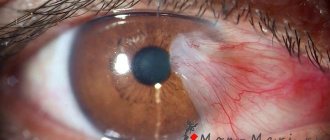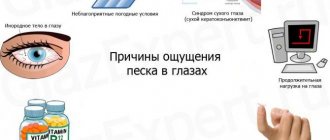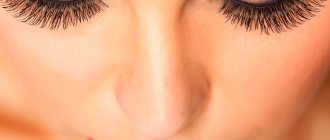Purulent discharge, redness of the eyelids, pain and swelling - this is not the entire list of manifestations that can accompany most ophthalmological diseases. In case of suppuration and swelling of the eye in adults and children, you should seek help from specialists, since self-medication can be harmful.
Only specialists can identify the cause of the development of pathology and correctly prescribe treatment after a comprehensive diagnosis. First of all, therapy should be aimed at reducing the tumor and draining purulent accumulations in the eyes.
Causes
The most common cause of red eyes is conjunctivitis.
The causes of conjunctivitis may be:
- infectious (for example, viral, bacterial, chlamydial);
- non-infectious (eg, allergies, irritants).
Other common causes of red eyes and purulent discharge include:
- blepharitis,
- abrasion of the cornea,
- foreign body
- subconjunctival hemorrhage,
- keratitis,
- iritis,
- glaucoma, chemical burn,
- scleritis
You need to see a doctor. The doctor will ask questions about unilateral or bilateral eye damage, duration of symptoms, type and amount of discharge, visual changes, severity of pain, photophobia, previous treatments, allergies or systemic disease, and whether the person wears contact lenses. Then he will examine your eyes. Next, we will look at the various diseases that lead to red eye.
Viral conjunctivitis
Viral conjunctivitis is usually very contagious. Especially caused by adenovirus. Conjunctivitis caused by infection with other viruses (such as herpes simplex virus) is less likely to spread. Viral conjunctivitis usually occurs through direct contact with contaminated fingers, medical instruments, pool water, or personal items. You can become infected from a person with an upper respiratory tract infection through coughing.
The clinical picture of viral conjunctivitis is usually mild with spontaneous remission after 1-2 weeks. Treatment is supportive and may include cold compresses, eye decongestants, and artificial tears. Antibiotics are not usually prescribed because secondary bacterial infections usually do not occur.
To prevent contracting viral conjunctivitis, you should wash your hands frequently and avoid sharing personal items. If the profession involves food processing and contact with people, then you should stop working until the discharge from the eyes completely disappears. Corticosteroid ointments are usually used. It is better not to treat yourself, but to consult an ophthalmologist.
Useful video
Useful information about eye suppuration can be found at the following links:
Suppuration of the eyes is a symptom of a large number of pathologies. Timely treatment of the organ of vision allows you to maintain the ability to see clearly. During therapy, you should carefully follow your doctor’s recommendations and never use medications on your own.
Author's rating
Author of the article
Alexandrova O.M.
Articles written
2031
about the author
Was the article helpful?
Rate the material on a five-point scale!
( 1 ratings, average: 1.00 out of 5)
If you have any questions or want to share your opinion or experience, write a comment below.
Bacterial conjunctivitis
Bacterial conjunctivitis is highly contagious and is most often spread through direct contact with contaminated fingers.
Based on the duration and severity of signs and symptoms, bacterial conjunctivitis is classified into:
- fulminant;
- spicy;
- chronic.
Fulminant bacterial conjunctivitis is often caused by Yersinia gonorrhea in sexually active adults. The infection is characterized by sudden onset and rapid progression, leading to corneal perforation. In this case, there is abundant purulent discharge, pain and decreased vision. You need to urgently contact an ophthalmologist and begin treatment immediately.
Acute bacterial conjunctivitis is the most common form of bacterial conjunctivitis. Signs and symptoms last less than 3-4 weeks. Staphylococcus aureus infection often causes acute bacterial conjunctivitis in adults. The pathogens Streptococcus pneumoniae and Haemophilus influenzae are most common in children.
Chronic bacterial conjunctivitis is characterized by signs and symptoms that persist for at least 4 weeks with frequent relapses. Patients with chronic bacterial conjunctivitis should be treated by an ophthalmologist.
Laboratory tests to identify bacteria and antibiotic susceptibility are performed only on patients with severe cases. Also, determination of the pathogen and sensitivity to antibiotics is recommended for patients with impaired immunity, people wearing contact lenses, and newborns. Also, a culture with an antibiogram is needed when initial treatment fails.
Typically, topical antibiotics are prescribed for the treatment of acute infectious conjunctivitis due to the difficulty of differentiating between bacterial and viral conjunctivitis.
The most commonly used antibiotics are:
- Azithromycin 1% (“Azasite”): 1 drop 2 times a day (with an interval of 8 to 12 hours) for 2 days, then 1 drop per day for 5 days.
- Besifloxacin 0.6% (“Bezivance”): 1 drop 3 times a day for 1 week.
- Ciprofloxacin 0.3% (“Siloxan”): 1 or 2 drops 4 times a day for 1 week. As an ointment: a pea-sized amount is applied to the conjunctival sac 3 times a day for 1 week.
- Erythromycin 0.5%. The ointment is applied 4 times a day for 1 week.
- Gatifloxacin 0.3% (Zymar) or Moxifloxacin 0.5% (Vigamox): 1 drop 3 times a day for 1 week.
- Gentamicin 0.3% (Gentac): 1 to 2 drops 4 times a day for 1 week. The ointment is applied 4 times a day for 1 week.
- Levofloxacin 1.5% (Iquix) or 0.5% (Quixin): 1 or 2 drops 4 times a day for 1 week.
- Ofloxacin 0.3% (“Ocuflox”): 1 or 2 drops 4 times a day for 1 week.
- Sulfacetamide 10% (“Bluff-10”): 1 or 2 drops every 2-3 hours for 1 week. The ointment is applied to the lower conjunctival sac 4 times a day and before bedtime for a week.
- Tobramycin 0.3% (Tobrex): 1 to 2 drops 4 times a day for 1 week. The ointment is applied to the conjunctival sac 3 times a day for 1 week.
- Trimethoprim, polymyxin B (“Polytrim”): 1 or 2 drops 4 times a day for 1 week.
The benefits of antibiotic treatment include faster recovery, earlier return to work or school, and prevention of further complications.
How to determine viral or bacterial conjunctivitis, watch the video:
Diagnostic methods
The most important and basic method for diagnosing any disease of the organs of vision, accompanied by the discharge of pus, is an examination by an ophthalmologist. Typically, the doctor carefully examines the cornea, eyelids, conjunctiva and other tissues. Along with this, he can take a smear to determine the form of bacterial infection. Sometimes it may be necessary to review the patient's medical history to make a more accurate diagnosis. It is also important to collect information from his complaints.
Chlamydial conjunctivitis
Chlamydial conjunctivitis is diagnosed in sexually active patients who have typical signs and symptoms of a red eye and purulent discharge but do not respond to standard antibacterial treatment. Patients with chlamydial infection may also have chronic follicular conjunctivitis. A conjunctival scraping followed by PCR analysis can be done, but this is not usually required.
Treatment includes local therapy with eye ointment with Erythromycin and oral therapy with Azithromycin (Zithromax) with a single dose of 1 g. Doxycycline 100 mg 2 times a day for 14 days can also be cured. This regimen is used to eliminate genital infections. The patient's sexual partners should also receive treatment.
Treatments with folk remedies
Traditional methods of therapy most likely will not help 100% get rid of suppuration of the eyes, swelling, puffiness, and also if the eyes have been itching for several days. However, thanks to some methods, it is possible to significantly improve the condition of the eyes, remove pain and accumulation of pus.
The fastest effect can be achieved by using these methods of treatment - washing the eyes with antiseptics, herbal infusions, solutions of potassium permanganate, chamomile and calendula. Washing should be done before each instillation of medications in the morning, immediately after waking up.
Allergic conjunctivitis
Allergic conjunctivitis is often associated with atopic diseases such as allergic rhinitis (the most common), eczema and asthma. The eyes are involved in an allergic reaction in approximately 25% of the population. A typical manifestation is itchy eyes. Seasonal allergic conjunctivitis is the most common form. The appearance of symptoms is associated with seasonal allergens, such as flowering plants. Protracted allergic conjunctivitis worries throughout the year. Avoidance of allergens and the use of artificial tears are recommended. Antihistamines and vasoconstrictors are also indicated for the treatment of allergic conjunctivitis.
The following drugs are recommended:
- Antagonists of histamine H1 receptors. Azelastine 0.05% (Optivar) – 1 drop 2 times a day. Emedastin 0.05% (“Emadin”) – 1 drop 4 times a day.
- Mast cell stabilizers. Cromolyn sodium 4% ("Krolom"). 1 or 2 drops every 4-6 hours.
- Lodoxamide 0.1% (“Alomid”). 1 or 2 drops 4 times a day. Nedocromil 2% (“Alocryl”). 1 or 2 drops 2 times a day.
- Mast cell stabilizers and H1 receptor antagonists. Ketotifen 0.025% (“Zaditor”). 1 drop every 8 to 12 hours. Olopatadine 0.1% (Patanol). 1 drop 2 times a day.
- Non-steroidal anti-inflammatory drugs. Ketorolac 0.5% (“Acular”). 1 drop 4 times a day.
- Vasoconstrictor and antihistamine. “Naphazoline”, “Pheniramine” – 1 or 2 drops up to 4 times a day.
The most effective option is a local 2nd generation histamine H1 receptor antagonist.
Dry eye syndrome
Dry eyes (keratoconjunctivitis) is a common condition caused by decreased tear production or poor tear quality. Occurs due to increasing age, being female, taking medications (for example, anticholinergics) and certain diseases. The diagnosis is made by a doctor based on the clinical picture and diagnostic tests.
Tear osmolarity is the best diagnostic indicator for dry eye. Overall diagnostic accuracy increases when tear osmolarity is combined with assessment of tear turnover and evaporation rates. Some patients with dry eye may experience ocular discomfort on examination without disruption of the tear film. In such people, treatment for dry eye can be initiated based on signs and symptoms. If Sjögren's syndrome is suspected, autoantibody testing should be performed.
Treatment includes frequent application of artificial tears during the day and evening application of lubricants that reduce the rate of tear evaporation. Using humidifiers and well-fitting glasses with side shields can also reduce tear loss. If artificial tears cause itching or irritation, you may want to switch to a preservative-free form or alternative.
When inflammation is a major factor in dry eyes, Cyclosporine ophthalmic drops will help increase tear production. Taking Cyclosporine can continue for several months until there is visible improvement. Systemic omega-3 fatty acids are also beneficial. Topical corticosteroids have been shown to be effective in treating inflammation associated with dry eye. The goal of treatment is to prevent scarring and perforation of the cornea. An ophthalmologist is needed to prescribe a course of topical steroids or undergo surgery.
How to cure dry eye syndrome, watch the thematic video:
Possible diseases
Today we can identify several of the most common eye diseases, which, with timely prescription of medications, can be cured quite quickly and without complications.
Inflammation of the cornea
Suppuration due to inflammation of the cornea (keratitis) is one of the symptoms. With this disease, vision deterioration may occur, up to its complete loss. The patient also experiences pain and burning.
Trauma and viral infection may be prerequisites for the appearance of the symptom. If treatment is not started in time, a cataract, blindness, and ulcers on the cornea may form.
Allergy
Pus in the eyes of an adult can only be released when there is severe inflammation due to allergies under the eyes, most often in the form of a symptom of allergic conjunctivitis. In this case, not only the eyelids, but also the conjunctiva, hair follicles, and mucous membranes can fester. You can prevent this unpleasant illness by taking antihistamines and removing the allergen (if possible).
Barley
Stye is one of the most common diseases and occurs in people of all ages. It is a purulent inflammation of the hair follicles of the eyelashes and sebaceous glands. The development of the disease begins with the formation of a small swelling, which over time develops into an abscess. This process is accompanied by pain, burning and other unpleasant sensations. The causative agent of the disease in most cases is staphylococcal bacteria.
Read about what ointment to use for stye on the eye here.
Demodectic mange of the eye
Every person has demodectic mites in small numbers. But a disease such as demodicosis of the eyes appears if there are an abnormally large number of such organisms on the body. It can be identified by the formation of yellowish discharge, suppuration and unbearable itching. Can be transmitted from person to person and from animal to person with weakened immunity.
Conjunctivitis
Almost everyone encounters the problem of conjunctivitis in life. Inflammation of the conjunctiva can have a different shape and character and is often accompanied by the release of cloudy fluid and purulence of the eye in more serious cases. The disease appears due to the introduction of dangerous and harmful fungi, bacteria and viruses to the conjunctiva.
Read how to treat bacterial conjunctivitis here.
Trachoma
As a rule, trachoma affects the cornea and conjunctiva and can spread deep into the eye tissue of varying densities. In later stages, boils may form and produce a yellow, sticky fluid. The causative agent of the infection is chlamydia.
Blepharitis
Blepharitis can be present on the patient’s eyelids in both acute and chronic forms. Among the main symptoms: inflammation and swelling of the eyelids, itching and discharge. To prevent the problem from becoming chronic, timely intervention is necessary. Unfortunately, not many people know how to treat it if the eyelid is inflamed.
Blepharitis
Blepharitis is a chronic inflammatory condition of the eyelid margins and is diagnosed based on symptoms and examination. The doctor examines patients for seborrheic dermatitis of the skin or face, redness and swelling of the nose or cheeks (rosacea). Therapy includes eyelid hygiene (cleansing with mild soap, diluted baby shampoo or eye cleansing solution). A light eyelid massage and warm compresses are recommended. These procedures should be done regularly.
Erythromycin or bacitracin ophthalmic ointment applied to the eyelids may be used in patients for whom hygiene procedures are insufficient. Azithromycin eye drops can also be used to treat blepharitis. In severe cases, long-term use of oral antibiotics (doxycycline or tetracycline) may be helpful. Steroids may be prescribed in severe cases.
Prevention
The main thing in the prevention of purulent eye diseases is compliance with hygiene and cleanliness rules:
- Use only personal hygiene items;
- If you wear contact lenses, follow all prescribed rules for storing and wearing them;
- Eat foods rich in vitamins (vegetables, fruits);
- Wash your hands regularly with soap or treat them with antiseptics or wet wipes;
- If you need to wipe or scratch your eyes, do not do it with dirty hands - use napkins.
Thus, suppuration of the eye can be caused by various reasons. Often this disease acts as one of the symptoms of a person’s underlying illness. When treating, it is important to use complex therapy and combine pharmaceutical drugs with traditional recipes. Maintain sterility and hygiene not only during the recovery period, but also in everyday life. This will help prevent re-infection or avoid complications.
Corneal abrasion
Corneal abrasion is diagnosed based on clinical presentation and eye examination. If necessary, fast-acting local anesthetics can be used to facilitate eye examination. The doctor also conducts an examination under a Wood's lamp. The doctor finds an infection or abrasion. An infection involving the cornea requires initiation of therapy by an ophthalmologist within 1-2 days. Patients with corneal abrasion may have a foreign body under the upper eyelid.
Treatment includes:
- supportive care;
- cycloplegics: atropine, cyclopentolate (cyclogyl), hematropine, scopolamine and tropicamide;
- pain control: topical nonsteroidal anti-inflammatory drugs (NSAIDs) or oral analgesics.
The need for antibiotics for uncomplicated abrasions has not been demonstrated. Aminoglycosides should be avoided because they are toxic to the corneal epithelium. All steroid medications are contraindicated in patients with corneal abrasion.
For information about corneal pathologies, watch the video:
Treatment with medications
How to treat such pathological manifestations? Full treatment is carried out only after an ophthalmologist has accurately determined the cause of the inflammatory process. Drug treatment includes the following:
- special antibacterial eye drops - Levomycetin, Albucid, Tobrex and tetracycline ointments;
- eye lotions;
- antiseptic eye drops – Oftamirin.
The prescription and use of other drugs depends on the identified cause. For chronic conjunctivitis, eye drops and ointments with hormonal effects are also prescribed. The allergic form of conjunctivitis is treated with antihistamines.
Subconjunctival hemorrhage
Subconjunctival hemorrhage is diagnosed clinically. It is not dangerous. The blood resolves within a few weeks and no special treatment is required. Warm compresses and ophthalmic lubricants such as hydroxypropylcellulose, methylcellulose, and artificial tears may relieve symptoms.
Subconjunctival hemorrhage
The doctor checks for corneal lesions or penetrating damage. Then urgent hospitalization to the ophthalmology department is needed. Recurrent bleeding may require evaluation for bleeding disorders. If the patient is taking Warfarin, the blood INR should be checked. To strengthen the vascular wall, Ascorutin is prescribed. For faster blood resorption, Emoxipin is recommended.










